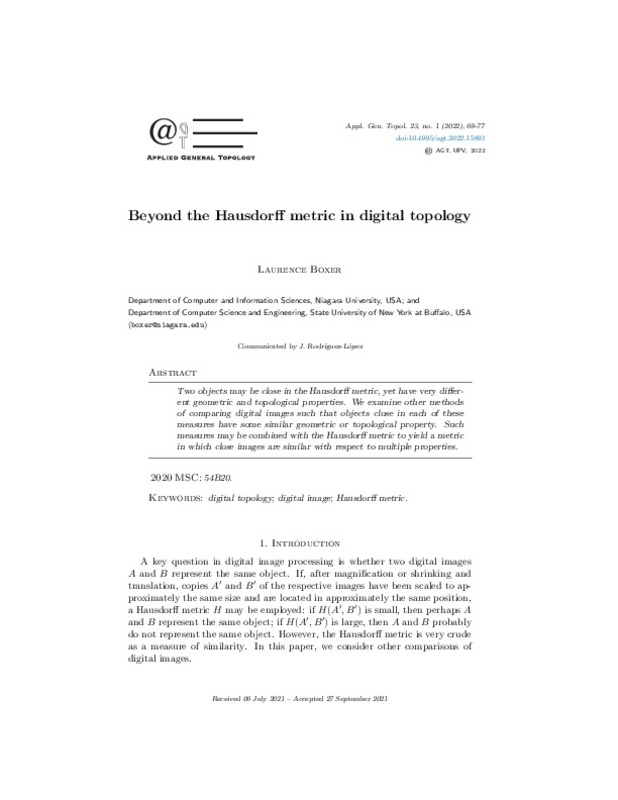JavaScript is disabled for your browser. Some features of this site may not work without it.
Buscar en RiuNet
Listar
Mi cuenta
Estadísticas
Ayuda RiuNet
Admin. UPV
Beyond the Hausdorff metric in digital topology
Mostrar el registro sencillo del ítem
Ficheros en el ítem
| dc.contributor.author | Boxer, Laurence
|
es_ES |
| dc.date.accessioned | 2022-05-25T07:50:50Z | |
| dc.date.available | 2022-05-25T07:50:50Z | |
| dc.date.issued | 2022-04-01 | |
| dc.identifier.issn | 1576-9402 | |
| dc.identifier.uri | http://hdl.handle.net/10251/182884 | |
| dc.description.abstract | [EN] Two objects may be close in the Hausdorff metric, yet have very different geometric and topological properties. We examine other methods of comparing digital images such that objects close in each of these measures have some similar geometric or topological property. Such measures may be combined with the Hausdorff metric to yield a metric in which close images are similar with respect to multiple properties. | es_ES |
| dc.language | Inglés | es_ES |
| dc.publisher | Universitat Politècnica de València | es_ES |
| dc.relation.ispartof | Applied General Topology | es_ES |
| dc.rights | Reconocimiento - No comercial - Sin obra derivada (by-nc-nd) | es_ES |
| dc.subject | Digital topology | es_ES |
| dc.subject | Digital image | es_ES |
| dc.subject | Hausdorff metric | es_ES |
| dc.title | Beyond the Hausdorff metric in digital topology | es_ES |
| dc.type | Artículo | es_ES |
| dc.identifier.doi | 10.4995/agt.2022.15893 | |
| dc.rights.accessRights | Abierto | es_ES |
| dc.description.bibliographicCitation | Boxer, L. (2022). Beyond the Hausdorff metric in digital topology. Applied General Topology. 23(1):69-77. https://doi.org/10.4995/agt.2022.15893 | es_ES |
| dc.description.accrualMethod | OJS | es_ES |
| dc.relation.publisherversion | https://doi.org/10.4995/agt.2022.15893 | es_ES |
| dc.description.upvformatpinicio | 69 | es_ES |
| dc.description.upvformatpfin | 77 | es_ES |
| dc.type.version | info:eu-repo/semantics/publishedVersion | es_ES |
| dc.description.volume | 23 | es_ES |
| dc.description.issue | 1 | es_ES |
| dc.identifier.eissn | 1989-4147 | |
| dc.relation.pasarela | OJS\15893 | es_ES |
| dc.description.references | A. Borat and T. Vergili, Digital Lusternik-Schnirelmann category, Turkish Journal of Mathematics 42 (2018), 1845-1852. | es_ES |
| dc.description.references | https://doi.org/10.3906/mat-1801-94 | es_ES |
| dc.description.references | K. Borsuk, On some metrizations of the hyperspace of compact sets, Fundamenta Mathematicae 41 (1954), 168-202. | es_ES |
| dc.description.references | https://doi.org/10.4064/fm-41-2-168-202 | es_ES |
| dc.description.references | K. Borsuk, Theory of Retracts, Polish Scientific Publishers, Warsaw, 1967. | es_ES |
| dc.description.references | L. Boxer, Computing deviations from convexity in polygons, Pattern Recognition Letters 14 (1993), 163-167. | es_ES |
| dc.description.references | https://doi.org/10.1016/0167-8655(93)90067-N | es_ES |
| dc.description.references | L. Boxer, A classical construction for the digital fundamental group, Journal of Mathematical Imaging and Vision 10 (1999), 51-62 . | es_ES |
| dc.description.references | https://doi.org/10.1023/A:1008370600456 | es_ES |
| dc.description.references | L. Boxer, Continuous maps on digital simple closed curves, Applied Mathematics 1 (2010), 377-386. | es_ES |
| dc.description.references | https://doi.org/10.4236/am.2010.15050 | es_ES |
| dc.description.references | L. Boxer, Convexity and freezing sets in digital topology, Applied General Topology 22, no. 1 (2021), 121-137. | es_ES |
| dc.description.references | https://doi.org/10.4995/agt.2021.14185 | es_ES |
| dc.description.references | L. Boxer, I. Karaca and A. Oztel, Topological invariants in digital images, Journal of Mathematical Sciences: Advances and Applications 11, no. 2 (2011), 109-140. | es_ES |
| dc.description.references | L. Boxer and R. Miller, Coarse grained gather and scatter operations with applications, Journal of Parallel and Distributed Computing 64 (2004), 1297-1320. | es_ES |
| dc.description.references | https://doi.org/10.1016/j.jpdc.2004.07.002 | es_ES |
| dc.description.references | L. Boxer and P. C. Staecker, Fundamental groups and Euler characteristics of sphere-like digital images, Applied General Topology 17, no. 2 (2016), 139-158. | es_ES |
| dc.description.references | https://doi.org/10.4995/agt.2016.4624 | es_ES |
| dc.description.references | L. Chen, Gradually varied surfaces and its optimal uniform approximation, SPIE Proceedings 2182 (1994), 300-307. | es_ES |
| dc.description.references | https://doi.org/10.1117/12.171078 | es_ES |
| dc.description.references | L. Chen, Discrete Surfaces and Manifolds, Scientific Practical Computing, Rockville, MD, 2004. | es_ES |
| dc.description.references | J. Dugundji, Topology, Allyn and Bacon, Boston, 1966. | es_ES |
| dc.description.references | S.-E. Han, Non-product property of the digital fundamental group, Information Sciences 171 (2005), 73-91. | es_ES |
| dc.description.references | https://doi.org/10.1016/j.ins.2004.03.018 | es_ES |
| dc.description.references | S.-E. Han, Digital fundamental group and Euler characteristic of a connected sum of digital closed surfaces, Information Sciences 177 (2007), 3314-3326. | es_ES |
| dc.description.references | https://doi.org/10.1016/j.ins.2006.12.013 | es_ES |
| dc.description.references | S. B. Nadler, Jr., Hyperspaces of Sets, Marcel Dekker, New York, 1978. | es_ES |
| dc.description.references | A. Rosenfeld, 'Continuous' functions on digital images, Pattern Recognition Letters 4 (1987), 177-184. | es_ES |
| dc.description.references | https://doi.org/10.1016/0167-8655(86)90017-6 | es_ES |
| dc.description.references | R. Shonkwiler, An image algorithm for computing the Hausdorff distance efficiently in linear time, Information Processing Letters 30, no. 2 (1989), 87-89. | es_ES |
| dc.description.references | https://doi.org/10.1016/0020-0190(89)90114-2 | es_ES |
| dc.description.references | H. I. Stern, Polygonal entropy: a convexity measure, Pattern Recognition Letters 10, no. 4 (1989), 229-235. | es_ES |
| dc.description.references | https://doi.org/10.1016/0167-8655(89)90093-7 | es_ES |
| dc.description.references | T. Vergili, Digital Hausdorff distance on a connected digital image, Communications Faculty of Sciences University of Ankara Series A1 Mathematics and Statistics 69, no. 2 (2020), 76-88. | es_ES |
| dc.description.references | https://doi.org/10.31801/cfsuasmas.620674 | es_ES |








